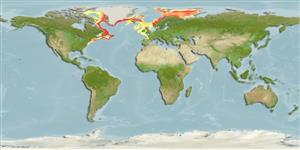Preferred temperature (Fonte Biblio.
123201): 0.8 - 7, mean 3.2 °C (based on 434 cells).
Phylogenetic diversity index (Fonte Biblio.
82804): PD
50 = 0.5312 [Uniqueness, from 0.5 = low to 2.0 = high].
Bayesian length-weight: a=0.00398 (0.00248 - 0.00639), b=3.19 (3.05 - 3.33), in cm total length, based on LWR estimates for this species & (Sub)family-body (Ref.
93245).
Trophic level (Fonte Biblio.
69278): 3.8 ±0.49 se; based on food items.
Generation time: 28.2 ( na - na) years. Estimated as median ln(3)/K based on 1
growth studies.
Resilienza (Fonte Biblio.
120179): Basso, tempo minimo di raddoppiamento della popolazione 4.5 - 14 anni (tm=15; tmax=25; Fec=25,000).
Prior r = 0.32, 95% CL = 0.21 - 0.47, Based on 1 data-limited stock assessment.
Fishing Vulnerability (Ref.
59153): High to very high vulnerability (75 of 100).
🛈
Climate Vulnerability (Ref.
125649): Moderate vulnerability (41 of 100).
🛈
Nutrients (Ref.
124155): Calcium = 12.2 [5.7, 24.0] mg/100g; Iron = 0.198 [0.103, 0.362] mg/100g; Protein = 16.6 [14.5, 18.7] %; Omega3 = 0.328 [0.147, 0.688] g/100g; Selenium = 32.3 [13.1, 73.1] μg/100g; VitaminA = 16.5 [3.6, 76.4] μg/100g; Zinc = 0.546 [0.348, 0.859] mg/100g (wet weight); based on
nutrient studies. 